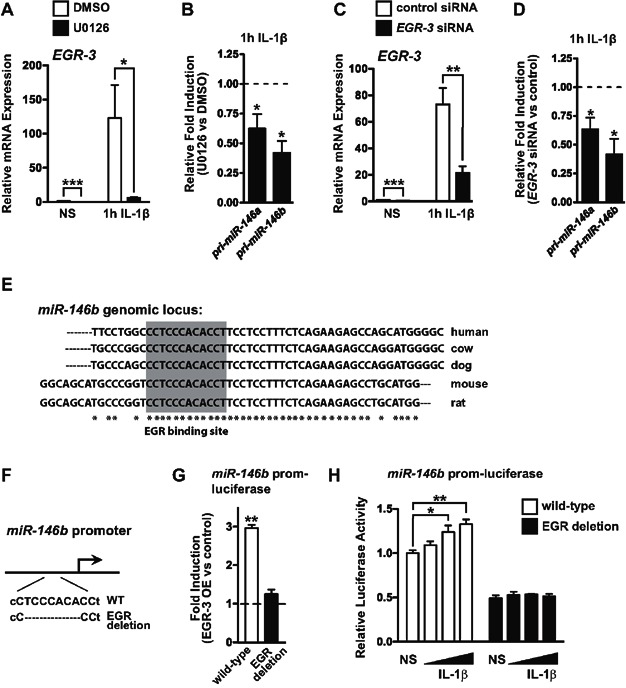Treatment of endothelial cells with the MEK inhibitor, U0126, inhibited the basal expression (t-test, p = 0.0003) and IL-1β-dependent induction (t-test, p = 0.037) of EGR-3 (n = 3).
Induction of pri-miR-146a and pri-miR-146b by IL-1β was reduced in cells pre-treated with the MAP kinase inhibitor, U0126. Data represents the relative induction of pri-miR-146a/b in cells treated with U0126 compared to cells treated with DMSO (vehicle) (n = 4). p = 0.037 for pri-miR-146a and p = 0.010 for pri-miR-146b (t-test).
EGR-3 knock-down by siRNA transfection reduced the basal (t-test, p < 0.0001) and IL-1β-induced levels (t-test, p = 0.004) of EGR-3 (n = 5).
The induction of pri-miR-146a and pri-miR-146b was also reduced in EGR-3 knock-down cells (n = 5). p = 0.023 for pri-miR-146a and p = 0.013 for pri-miR-146b (t-test).
Schematic indicating a potential EGR binding site (shaded area) in the miR-146b promoter. Sequence comparison between various species is indicated. Asterisks indicate conserved nucleotides across all species.
Schematic of deletion of the EGR binding site in the miR-146b promoter.
A miR-146b promoter-luciferase reporter was responsive to EGR-3 over-expression (OE) in bovine aortic endothelial cells (BAEC) and mutation of a conserved EGR binding site abrogated this responsiveness. Data depicts the fold induction with EGR-3 OE compared to control. Shown is a representative experiment (n = 3 replicates). p = 0.0017 (t-test).
A miR-146b promoter-luciferase reporter was modestly induced in response to IL-1β and this induction was not observed when the EGR site was mutated. IL-1β was added at concentrations of 10, 20 or 40 ng/mL. Shown is a representative experiment (n = 3 replicates). ANOVA, p = 0.011. * and ** indicate a significant difference between the indicated groups, p < 0.05, p < 0.01, respectively.

